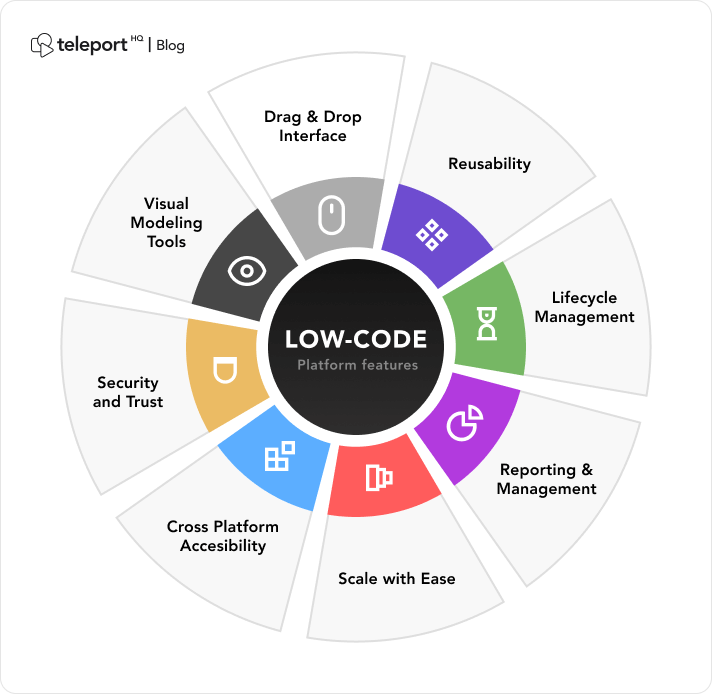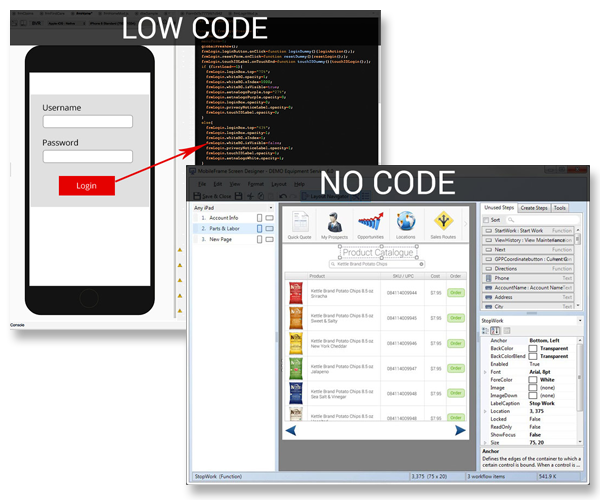The development of applications using low-code significantly improves development speed because of several key factors: Visual Development Environment:
Drag-and-Drop Interfaces: Low-code platforms provide visual tools for designing applications. Drag-and-drop elements can be used by developers to build apps quickly without extensive code.
A lot of low-code platforms come with already-built templates or components that permit developers to quickly test their apps and build them without having to start from scratch.
Reduced Coding Requirements
Automated Generated Code: Lowcode platforms create the code base on the visual models developed by developers. This reduces the requirement to code manually and speeds up development.
Reusable Parts: Developers will have the ability to reuse reusable components across different projects, and cut down on the time needed for writing and testing code.
Collaboration is streamlined:
Low-code platforms have a myriad of tools that allow seamless collaboration between teams working on development. They include version control, testing and deployment.
Citizen development: By using user-friendly interfaces and reducing bottlenecks often caused by the insufficient availability of business users, developers and other users can assist in application development.
Rapid Iteration and Prototyping:
Rapid Prototyping: Developers design prototypes quickly to validate ideas and gather feedback. This results in a faster iteration cycles.
Simple Modifications. The visual nature of low-code development allows users to modify and update their software.
Pre-built Integrations:
API Integrations: Platforms that are low-code often have pre-built connectors for APIs and services that are popular making it easier to connect external systems.
Data integration: Tools to integrate data are included to help simplify the process.
Deployment and Scaling
Many low-code platforms have one-click options for deployment that reduces the time and effort required to set up applications.
Cloud-based solutions: Cloud platforms with low-code enable developers to focus on the functionality and logic of their applications rather than worrying about the logistics of deployment.
All in all, low-code development offers the advantage of speed due to its capacity to automate and simplify many elements of development. This allows faster delivery of apps and easier adaptation to evolving needs. Take a look at the top rated Low-code Platform for application development info for site tips including develop web application, app platforms, rapid app development, push notifications, rad application development, app modernisation, cross platform mobile development, push alerts, jdbc server, ms azure sql and more.

Benefits Of Developing Applications Using Low-Code In Terms Of Flexibility And Scale
Low-code development has several benefits in terms of flexibility and scalability that are essential for developing applications that can be capable of growing and adapting to the changing needs of business. Here are the major advantages:
Cloud-Based deployment: Many lowcode platforms run on cloud computing, which allows applications to scale up with the underlying infrastructure. Businesses can manage more workloads without having to worry about server management.
Auto-Scaling Feature: Built-in features that automatically scale resources in order to satisfy demand, ensuring consistent performance without manual input in peak hours.
Flexible Architecture:
Modular design: Low-code platforms are a great way to promote modular applications. This lets components be designed and developed on their own, tested, scaled or even resized. Modularity improves flexibility and allows to upgrade or expand certain components of a program without affecting the whole system.
Microservices Architecture: The Microservices architecture allows the creation of applications by creating a loosely coupled collection of services. This improves scalability & flexibility.
Customizable Solutions:
Extensibility: Low-code platforms typically allow customization of scripts and codes, which lets developers expand the functionality of applications beyond what is available in the box. This ensures that unique business needs can be fulfilled without a limit.
Third-Party Integrations: The capability to integrate with third-party applications and APIs enables companies to integrate additional features and services when needed to enhance the functionality of the application.
Agile Development and Deployment
Continuous Delivery and Deployment Low-code platforms support agile methodologies which allow continuous integration as well as continuous delivery (CI/CD). This allows rapid deployment of updates and new features, which allows applications to evolve quickly as a result of user feedback and changes in the market.
Iterative Design: Since low-code is an iterative procedure the applications can be gradually improved and enlarged. This permits controlled growth, and minimizes the risk of large-scale changes.
Resource Optimization:
Efficient Resource Management: Low-code platforms help optimize the usage of resources through providing tools to monitor and manage application performance. It ensures that resources can be utilized effectively and efficiently scaled up or back down depending on actual requirements.
Load Balancing: Integrated load balancing functions distribute the workload equally across servers, improving the capacity of applications to handle heavy traffic and guaranteeing consistent performance.
Global Reach:
Multi-Region Deployment: Low code platforms typically support deployment across several geographical regions, which allows businesses to provide low-latency services to users across the globe. This is crucial for applications that have a large global user base.
Support for Localization. Inbuilt support for localizing applications allows them to be easily adapted to different languages, regional requirements and enhances their flexibility across different markets.
Maintenance and updates:
Simplified maintenance: The graphic and module nature of low-code applications makes it easier to complete the maintenance tasks. They permit updates and bug fixes to be made quickly without extensive downtime.
Version Control: The integrated system for controlling version allows the safe release of rollbacks and updates. Previous versions can also be restored in the event that they are needed.
Cost Efficiency:
Lower Development Costs: By cutting down on the need for extensive programming, low-code platforms reduce development costs and enable to scale apps without a substantial increase in cost and effort.
Pay-As-You Go Models - Many low-code applications have flexible pricing models, such as pay-as-you go that aligns costs with actual usage, growth as well as financial flexibility.
Overall, the scalability and flexibility advantages of low-code applications let businesses build robust, flexible and scalable applications quickly. These platforms permit rapid changes to meet changing demands, efficient resource utilization, and constant enhancement. Applications can expand and evolve with the needs of the business. Take a look at the best Legacy application modernization with Low-code examples for more examples including application modernization, cross platform mobile dev, no code platforms, mobile development platforms, develop mobile application, push alerts, push alerts, push notifications, stored sql procedures, microsoft azure sql and more.

Regarding Support From Vendors And Community, Low-Code Applications Development Has Many Advantages.
Low-code development platforms have distinct advantages when it comes to support for vendors as well as the community. These are crucial for successful implementations, continual maintenance, as well as continuous improvement. Here are some key advantages.
Comprehensive Technical Support:
Dedicated Support Teams A lot of low-code platforms have dedicated support teams who can help with technical issues, problem solving and provide guidance. This will ensure that any issues will be quickly addressed.
Certain vendors provide 24/7 support. This is especially beneficial for businesses that operate globally and have different time zones.
Training and Onboarding
Vendors typically offer user-friendly programs, such as tutorials and webinars. They might also offer certification courses.
Personalized onboarding: Many vendors have personalized services for new customers, to help them implement the platform properly and to customize it to meet their requirements.
Updates and Enhancements, Regularly, and Enhancements:
Continuous Improvement: Low-code platform vendors typically release regular updates that include the latest features, performance enhancements as well as security patches, ensuring that the platform remains cutting-edge and secure.
Feedback Integration: Vendors include user feedback in their development cycles to ensure that the platform is constantly evolving to meet the evolving needs of their users.
Comprehensive Documentation:
Documentation - Comprehensive detailed and well organized documentation, ranging from basic use to advanced modifications and is usually available. This allows users to solve issues on their own.
API References API documentation provides specific API references that can help developers integrate their low-code platform applications with other platforms.
Professional Consulting Services
Expert Consulting. Vendors offer a wide range of services for consulting, such as architectural design, strategic planning and complex platform implementations. They ensure that customers are able to maximize the benefits of their platform.
Custom Development: Certain vendors provide services that permit them to develop specific features or the features, but they aren't available out of the box.
Community Support for the Community
Active User Community:
Discussion boards and forums: Many low code platforms offer vibrant online communities that allow users to discuss issues, share solutions and work together on best practices.
User Groups and Meetups: User groups, both virtual and local and meetups offer opportunities to network, learn and sharing your experiences with other users.
Collaboration and Knowledge Sharing
Community-Contributed Resources: Users often share templates, modules, and extensions that they have developed, which can be reused or adapted by others, accelerating development and innovation.
Crowdsourced Solutions: The collective knowledge and experience of a community can be an effective tool for troubleshooting and finding creative solutions.
Learning and Development
Community-Led training: Many communities provide webinars, workshops, and training sessions led by knowledgeable users.
Online Tutorials and Courses: Members of the community frequently publish online tutorials, courses and instructions on how to accomplish things that enhance learning resources.
Feedback and Influence:
Product Feedback Channels: Community forums typically provide feedback to the vendor, which can influence the development of new features or improvements.
Beta Testing Programs: Active members of the community might be able to take part in beta testing programs. They will get the chance to see first-hand new features and also the chance to influence the development of the platform.
Recognition and Support
Community Recognition Programs: Many vendors offer recognition programs to recognize the contributions made by active members of their communities and include MVP (Most Valuable Professionals) programs.
Peer support: Community members are often willing to offer support to peers, providing their knowledge and guidance for those less familiar. They foster a collaborative environment through encouraging cooperation and creating a positive atmosphere.
In the end, the combination of of strong vendor support and an active and engaged community results in a comprehensive support eco-system to develop low-code applications. It makes sure that users have access to the resources, expertise and collaboration opportunities to be able to build and implement their apps.
